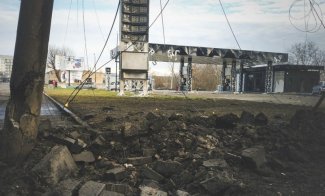Strong Russian strike in Khmelnytskyi oblast. Day 610 of the war

Russian forces recorded advances to the south-east of Avdiivka, where they took up positions in the built-up area of the town; according to some sources, they also made progress to its south-west, reaching the main line of Ukrainian fortifications in the area. They also repulsed counterattacks by the defenders on the northern outskirts of Avdiivka. The Russian troops are located about 3.5km north and 5km south of the only Ukrainian-controlled road to the town (via Orlivka). According to the local administration, six civilians (out of 1595 who remain) were persuaded to leave and evacuated within three days. Subdivisions of mercenaries from the Wagner Group were allegedly brought into the Avdiivka area. Kyiv and its Western partners stress that the invaders have suffered heavy casualties in the fighting for the town, and in recent days have reduced their use of armoured weapons in favour of artillery-supported attacks by infantry groups. US National Security Council spokesman John Kirby estimated the total Russian losses at Avdiivka between 11 and 26 October at “more than a battalion”, and said that 125 vehicles had been destroyed in the process. Ukrainian sources claim that 200 enemy armoured vehicles were destroyed.
The Russians – without much success – have continued their operations to the north and south-east of Kupyansk (the authorities of Kharkiv oblast decided to forcibly evacuate a further 10 villages), to the north and south-west of Bakhmut, and in and south of Marinka. According to the Ukrainian General Staff, as of 25 October the invaders have halted their attacks in the remaining directions, and they are now expected to try and regroup. However, the total number of assaults on the defenders’ positions has fallen slightly, from 80 to 70 per day. The Ukrainian side’s renewed attacks south of Orikhiv and their attempts to expand their bridgeheads on the left bank of the Dnieper also failed to produce results, although on 25 October the General Staff reported partial success west of the village of Verbove.
On 25 October, Russian kamikaze drones struck the Shepetivka raion of Khmelnytskyi oblast; their target was most probably the 47th Arsenal of the Main Rocket and Artillery Directorate, southeast of Slavuta (according to Kyiv’s account, an infrastructure facility there was damaged). There was a powerful shock and a series of subsequent explosions, and a shockwave was created which reached the Khmelnytskyi Nuclear Power Plant (NPP) 20 km away. The International Atomic Energy Agency reported that the impact of the wave damaged windows in several buildings at the unit (as a result of falling debris from drones, according to Kyiv). The military administration of Khmelnytskyi oblast announced that a total of 1760 sites of various types had been damaged, mainly in Slavuta, and to a lesser extent in the nearby power plant town of Netishyn, injuring20 people. The Ukrainian General Staff announced that the enemy had used 11 Shahed-136/131 drones in the attack, all of which were shot down.
On 25–27 October, Russian missiles struck the Pokrovsk raion of Donetsk oblast, as well as Izium in Kharkiv oblast, while drones struck Mykolaiv and Odesa oblasts. According to a communiqué from the Ukrainian side, a total of six Shahed-136/131 drones were used by the enemy in the 27 October attack, five of which were neutralised.
According to Russian sources, on 26 October three Ukrainian kamikaze drones were said to have unsuccessfully attacked the Kursk NPP, one of them exploding over a radioactive waste dump. Meanwhile some Ukrainian media reported powerful explosions in Sevastopol on the evening of 24 October.
On 26 October, the Pentagon announced the US’s 49th military support package for Ukraine, this one worth $150 million. It included missiles for the NASAMS and HIMARS systems, AIM-9M air-to-air missiles (for use as surface-to-air missiles), missiles for the Stinger man-portable air-defense systems and Javelin & TOW anti-tank systems, 155-mm and 105-mm artillery ammunition, and more than 2 million rounds of small-arms ammunition. On the same day, Denmark presented its 13th military support package, worth 3.7 billion kroner ($522.6 million). It includes ex-Czech T-72 tanks and BMP-2 infantry fighting vehicles, armoured recovery vehicles, ammunition and drones. On 25 October, another military aid package (worth $20 million) was announced by Australia; it includes 3D industrial printers and drone combat systems. a spokesman for the US Air Force reported that “a small group of Ukrainian pilots” had begun learning the basics of flying F-16 fighter jets.
On 24 October, Ukraine’s prime minister Denys Shmyhal reported that Rheinmetall and Ukrainian Defense Industry (UDI, formerly Ukroboronprom) joint-stock company had established a joint venture in Kyiv on the 18th of the month. The German company, together with Ukrainian companies, is to overhaul and service armaments and military equipment transferred to Kyiv. On the same day the world’s largest drone maker, the Chinese company DJI, denied Shmyhal’s statement of 8 October in which he claimed that Ukraine was buying 60% of the entire global production of Mavic drones. DJI’s communiqué noted that the Prime Minister could have no knowledge of the scale of the company’s production.
On 26 October, Bloomberg reported that the EU has so far fulfilled only 30% of its plan to supply artillery ammunition to Ukraine (1 million rounds within 12 months, i.e. by March 2024), and that several member states are proposing to extend the deadline. The main problems include a significant increase in the price of the shells, exceeding the funds budgeted for them (the day before, Germany’s Die Welt reported that Rheinmetall had raised the price of a 155-mm calibre cartridge from €2000 in 2022 to €3600). Lithuania’s foreign minister Gabrielius Landsbergis contrasted the EU’s deliveries to Kyiv to date (300,000 missiles) with the alleged scale of North Korea’s deliveries to Russia (350,000). On 26 October the UK Ministry of Defence reported that artillery shell deliveries from North Korea to the Russian Federation had been ongoing since September, although according to the British they have not yet reached the front line.
On 25 October, Serhiy Rakhmanin, a member of the parliamentary Committee on National Security, Defence and Intelligence, admitted that after the president dismissed all the heads of conscription commissions and introduced anti-corruption controls, the scale of mobilisation in some regions had fallen from 80 to 10 per cent. In his opinion, involving officers in the activities of these bodies has proved to be an ineffective move as they are not ready to work in a bureaucratic system.
The Security Service of Ukraine (SBU) has announced the neutralisation of Russian groups engaged in sabotage and espionage. On 25 October, members of a cell that had been operating since April this year preparing terrorist attacks on behalf of the Federal Security Service were detained in Kyiv and Chernihiv. The agents were collecting explosives and weapons to be used in the destruction of military and critical infrastructure. The SBU said the group’s priority targets included infrastructure used by the General Staff and the Ministry of Defence, as well as reserve command posts. To determine the location of the facilities, the agents obtained information from acquaintances serving in the military and used drones for reconnaissance. A day later, the SBU captured three people in Sumy oblast who had been collecting data on the location of Ukrainian units near the border with Russia in order to guide artillery shelling and air attacks. On 24 October, meanwhile, it announced that enemy special services had made unsuccessful attempts to engage Ukrainian minors in anti-Semitic speeches in Zhytomyr, Dnipropetrovsk, Lviv and Vinnytsia oblasts.
On 25 October, Ukraine’s Deputy Foreign Minister Anton Demokhin stated that Russian cyber-attacks are becoming increasingly sophisticated, and are aimed at destroying critical infrastructure. Hackers are still attacking government agencies, security services and businesses, including financial institutions, in an attempt to obtain personal data and disrupt IT systems. As he put it, these incidents have become more coordinated: several people in different locations attack different parts of the same infrastructure simultaneously. Hackers are also introducing dormant ‘time-bomb’ viruses into various systems, which can be activated after some delay. 3974 cyber-incidents were recorded in Ukraine between January 2022 and September this year.
On 24 October, the head of information services of Operational Command ‘South’, Nataliya Humeniuk, reported that Russian air force activity had been registered in the area of the shipping corridor for ships sailing to and from Odesa. According to Humeniuk’s statement, enemy aircraft dropped four suspected payloads into the sea that could have been sea mines. Two days later, Ukrainian Navy spokesman Dmytro Pletenchuk said that Russia would seek to increase the threat to civilian shipping in the Black Sea and disrupt grain supplies using Ukrainian mines captured in Crimea.
On 26 October Ukrainian military intelligence (HUR) revealed that four FSB officers had been killed in occupied Berdyansk in a bombing three days earlier. The HUR leadership described the incident as ‘revenge’ carried out by the Ukrainian resistance movement.
On 25 October, the press service of the Territorial Defence Forces announced the creation of an experimental unit for the protection of cultural heritage sites. It will record the destruction and condition of monuments in the frontline zone and organise the evacuation of works of art deep into Ukraine. Specialists in the protection of cultural heritage sites will be engaged to work in the Ukrainian army’s area of operations.
Commentary
- The external damage from the Russian strike in the Shepetivka raion of Khmelnytskyi oblast is likely to be the largest ever recorded in attacks deep inside Ukrainian territory. Most of the damage was probably caused by the impact from the shockwave. The relatively small number of casualties and lack of fatalities (at least among civilians; Kyiv does not report military casualties from enemy drone or missile strikes) should also be attributed to this. The formation of the wave indirectly confirms that an ammunition depot was hit, although what type of explosives was stored there remains uncertain. A similar hit on a facility of this type in Khmelnytskyi oblast in May allegedly destroyed tank ammunition with depleted uranium cartridges which had been supplied by the UK. Despite the powerful explosion of that arsenal, the scale of external damage at that time was much smaller. It cannot be ruled out that the explosion was not caused by drones, but by a missile used simultaneously with them in a combined attack; in the May strike, a hypersonic Kinzhal was said to have hit the munitions. However, Kyiv’s strict information policy means that reporting on the attacks and their effects is as limited as possible, with only the shoot-downs of enemy drones and missiles being reported.
- The Ukrainian side (including in an evening speech by President Volodymyr Zelensky) tried to present the attack on 25 October as an attempt to strike the Khmelnytskyi NPP. This is also the reason for Russian reports of an alleged Ukrainian drone attack on the Kursk NPP a day later. In all likelihood, however, the latter did not happen, and the false report about it was intended to neutralise potential damage to Russia’s reputation if the Ukrainian report about the attack on the Khmelnytskyi NPP had been successful. Both Kyiv nor Moscow, however, have stopped promoting the story of an attack on the nuclear facilities; this should be linked to the relatively quick public response from the International Atomic Energy Agency.






